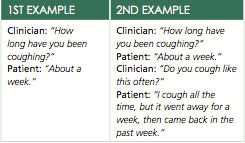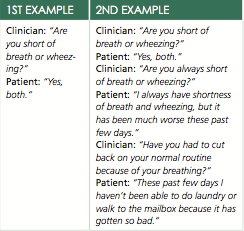Chronic Bronchitis
Chronic obstructive pulmonary disease and its subtypes, such as chronic bronchitis and emphysema, affect more than 5% of the population and is the third-ranked cause of death in the United States.
Epidemiology and Definitions
Chronic obstructive pulmonary disease (COPD) and its subtypes, such as chronic bronchitis and emphysema, affect more than 5% of the population and is the third-ranked cause of death in the United States. In 2012, COPD caused 3 million deaths—6% of worldwide deaths that year.1Due to its high prevalence and chronicity, the disease represents a large burden of care on the health care system. In 2010, the disease resulted in an estimated cost of $32.1 billion in the United States.2There is substantial overlap between the COPD subtypes and other airflow-limiting diseases, such as asthma, bronchiectasis, and bronchiolitis.
Chronic bronchitis is specifically defined as a chronic productive cough lasting 3 months in each of 2 successive years in cases where other causes of cough have been excluded.3An acute exacerbation of COPD is defined as an increased sputum production, an increase in dyspnea, a change in the color of the sputum from clear to white to green or yellow, or an increase in a cough.4It may be triggered by a viral or a bacterial infection or environmental pollutants. Allergens, chemical toxins, air pollution, and noncompliance to drug therapy are also well-known risks. Exacerbations manifest in airway inflammation, hyperinflation, and reduced air flow and gas exchange. With worsening COPD, exacerbations become more prevalent.
Presentation
Acute exacerbations of chronic bronchitis, the focus of this article, typically manifest in worsening cough, increases or changes in sputum production, and worsened dyspnea. A thorough medical histo- ry should include the following features:
• Time course of the symptoms
• Comparison to the patient’s baseline symptoms
• Definition of severity
• Sputum characteristics
With cough being the most common sign of chronic bronchitis, and a cough also representing a common complaint for which patients seek treatment in the clinic, it is no wonder the paths collide. Oftentimes, differentiating between a chronic cough that is at its baseline, a chronic cough that is an exacerbation, and an acute cough proves difficult even for the astute clinician, who needs to tease out details regarding the complaint.
One of the first questions in obtaining the history involves acquiring a time frame. Not only is it important to find out how long a patient’s current cough has been ongoing, it is also key to know how common a cough is to the patient.
Consider 2 different examples of obtaining a history with a complaint of cough:

These 2 different basic conversations show the importance of obtaining a detailed history. If, with the first inquiry, the health care provider merely stopped with the patient’s answer of “About a week,” it can be interpretedas an acute cough, such as that which occurs with sinusitis or a common cold. However, further probing, as seen with example 2, suggests a more chronic problem that requires completely different treatment.
The 3 most prominent symptoms of COPD are chronic cough, dyspnea, and sputum production. Less common are wheezing and chest tightness, and each of these symptoms can present with varying degrees of intensity. The variation can be over the course of a day or week-to-week. Morning is usually the worst time of day for these patients.5
Assessment includes not only symptom presence and severity, but also an inquiry of how much a change from baseline it is. Let’s revisit the 2 clinical scenarios:

It is easy—and important—to see how much the patient’s breathing is affecting his or her activities of daily life, and how much of a change from baseline it is, with more specific questioning. Sputum should be characterized by its amount and purulence and whether or not there is blood. However, it should be noted that colored mucus is not necessarily indicative of a bacterial infection.6
It’s also important to take note if the patient has had an extensive history of prior exacerbations. When the patient presents in the clinic, it is paramount to assess risk factors when obtaining the history. These include:
• Family history
•Smoking history, including age at initiation and average amount
• Environmental history
• Asthma
Carefully assess for comorbid conditions, which can confuse the COPD picture. These include heart failure, cardiovascular disease, bronchiectasis, deconditioning, lung cancer, and anxiety, among others. Consider an alternate diagnosis from chronic bronchitis exacerbation if symptoms such as fevers, night sweats, chest pain, hypotension, or edema are present. Beyond the vitals, a physical examination should include inspecting the head, ears, nose, throat, and neck. The chest might reveal wheezing and tachypnea, course cough, and accessory muscle use for a chronic bronchitis exacerbation. Crackles are often heard. On cardiovascular exam, pay attention for tachycardia or arrhythmia.
Tests should also include a pulse oxygen saturation, and a chest radiograph should be ordered to rule out an infiltrative process or effusion, particularly in patients with fever or hemoptysis. Laboratory studies may include serum electrolytes and a complete blood count (to identify polycythemia or anemia). In severe cases, arterial blood gas analysis provides information if there is concern for hypercapnia or hypoxemia. Spirometric testing is typically not recommended for acute exacerbations of chronic bronchitis because results can be inaccurate in such a setting.7
Other tests, such as electrocardiogram or brain natriuretic peptide, are obtained contingent upon the clinical presentation of the patient. Sputum cultures are not of much use for COPD exacerbations unless there is strong suspicion of bacterial infection not responding to initial antimicrobial therapy. When suspected, obtain an influenza swab.
Management
GOLD guidelines that recommend hospitalization are as follows8:
• Inadequate response to outpatient management
• Significant change from baseline symptoms
• Severe underlying COPD, defined as forced expiratory volume in 1 second (FEV1) <50%
• New onset of cyanosis or peripheral edema, or other profound signs
• Acute respiratory acidosis
• Older age
• Frequent and recurrent exacerbations
• Comorbid conditions, such as pneumonia, heart failure, diabetes, or renal failure
• Lack of home support
Treatment for chronic bronchitis exacerbations includes beta-agonists, anticholinergic agents, oral glucocorticoids, and other ancillary support. Intensification of bronchodilator therapy with inhaled short-acting albuterol or levalbuterol is a mainstay of therapy due to its rapid onset of action and efficacy. Although most studies have not proven that nebulizer administration of beta-agonists is superior to the handheld inhalers, several patients prefer the nebulizer, and it should be considered for exacerbations.
Long-acting bronchodilators are successful in reducing exacerbations and hospitalizations, as well as improve symptoms.8Short-acting anticholinergics, such as ipratropium, are also effective bronchodilators and typically used in combination with the inhaled beta-agonists.8A metered dose inhaler should administer ipratropium with 2 puffs every 4 to 6 hours. The soft mist inhalers (eg, Respimat) endorse the combination to be dosed at 1 inhalation every 6 hours.
GOLD tells us that combination bronchodilators, compared with single bronchodilator therapy, of different pharmacologic classes may prove more efficacious and reduce adverse effects.7Current GOLD guidelines suggest taking prednisone at 40 mg daily for 5 days.8However, depending on severity and known prior response to therapy, clinical practice often denotes a higher or longer course of oral glucocorticoids.
Outpatient treatment of chronic bronchitis exacerbations does not come with well-established data to support antibiotic treatment. As such, GOLD guidelines do not recommend antibiotic treatment except for situations where there is suspected concurrent infection. Clinically, in those with mild exacerbations (ie, those with increased dyspnea, increased sputum volume, or increased sputum puru- lence, but not all 3), antibiotics are typically not indicated.
If antimicrobial therapy is being considered and local antibiotic resistance patterns are being taken into account, antibiotics targetingHaemophilus influenzae,Moraxella catarrhalis, andStreptococcus pneumoniaeshould be considered. Macrolide antibiotics, doxycycline, trimethoprim-sulfamethoxazole, or a cephalosporin are recommended for COPD exacerbations in most uncomplicated cases. In more complicated patients, amoxicillin-clavulanate or levofloxacin or moxifloxacin are the recommended agents.
Adjunctive care for chronic bronchitis exacerbations includes cigarette smoking cessation, avoidance of environmental triggers, and, for those who qualify, oxygen therapy. Rehabilitative services, such as exercise training programs to improve exercise tolerance and reduce dyspnea, are valuable for long-term benefit. Similarly, maintenance of health status can be afforded if the patient continues his or her exercise training at home.8
Supplemental oxygen should be titrated to a goal of 88% to 92%. Long-term oxygen administration for chronic respiratory failure has been shown to improve survival in patients with severe disease and resting hypoxemia, defined as an oxygen saturation at or below 88%.8
Michele Brannan, MPAS, PA-C, earned her bachelor’s degree in health science and her master of physician assistant studies degree from Gannon University. She started her career working in cardiology at St. Louis University before joining Alton Internal Medicine in Alton, Illinois, where she has practiced for more than 10 years.
References
1. World Health Organization. Chronic obstructive pulmonary disease (COPD) fact sheet. WHO website. who.int/mediacentre/factsheets/fs315/en/. Published March 2015. Accessed October 25, 2016.
2. CDC reports annual financial cost of COPD to be $36 billion in the United States [news release]. Glenview, IL: American College of Chest Physicians; July 24, 2014. chestnet.org/News/Press-Releases/2014/07/CDC-reports-36-billion-in-annual-financial-cost-of-COPD-in-US. Accessed November 8, 2016.
3. Vestbo J. Global strategy for the diagnosis, management and prevention of COPD, global initiative for chronic obstructive lung disease.Am J Respir Crit Care Med.2013;187(4): 347-365. doi: 10.1164/rccm.201204-0596PP.
4. Elbehairy AF, Raghavan N, Cheng S, et al. Physiologic characterization of the chronic bronchitis phenotype in GOLD grade IB COPD.Chest. 2015;147(5):1235-1245. doi: 10.1378/chest.14-1491.
5. Gruber P. The acute presentation of chronic obstructive pulmonary disease in the emergency department: a challenging oxymoron.Emerg Med Pract.2008;10(11).
6. Kessler R, et al. Symptom variability in patients with severe COPD: a pan-European cross-sectional study.Eur Respir J.2011;37(2):264-272. doi: 10.1183/09031936.00051110.
7. Acute Exacerbations of Chronic Bronchitis. MedBroadcast website. medbroadcast.com/condition/getcondition/Acute-Exacerbations-of-Chronic-Bronchitis. Accessed October 30, 2016.
8. Global Initiative for Chronic Obstructive Lung Disease. goldcopd.org/. Accessed October 30, 2016.

Knock Out Aches and Pains From Cold
October 30th 2019The symptoms associated with colds, most commonly congestion, coughing, sneezing, and sore throats, are the body's response when a virus exerts its effects on the immune system. Cold symptoms peak at about 1 to 2 days and last 7 to 10 days but can last up to 3 weeks.
COPD: Should a Clinician Treat or Refer?
October 27th 2019The Global Initiative for Chronic Obstructive Lung Disease (GOLD) defines the condition as follows: “COPD is a common, preventable, and treatable disease that is characterized by persistent respiratory symptoms and airflow limitation that is due to airway and/or alveolar abnormalities usually caused by significant exposure to noxious particles or gases.â€
Diabetic Ketoacidosis Is Preventable With Proper Treatment
October 24th 2019Cancer, diabetes, and heart disease account for a large portion of the $3.3 trillion annual US health care expenditures. In fact, 90% of these expenditures are due to chronic conditions. About 23 million people in the United States have diabetes, 7 million have undiagnosed diabetes, and 83 million have prediabetes.
What Are the Latest Influenza Vaccine Recommendations?
October 21st 2019Clinicians should recommend routine yearly influenza vaccinations for everyone 6 months or older who has no contraindications for the 2019-2020 influenza season starting at the end of October, according to the Advisory Committee on Immunization Practices.
What Is the Best Way to Treat Pharyngitis?
October 18th 2019There are many different causes of throat discomfort, but patients commonly associate a sore throat with an infection and may think that they need antibiotics. This unfortunately leads to unnecessary antibiotic prescribing when clinicians do not apply evidence-based practice.
